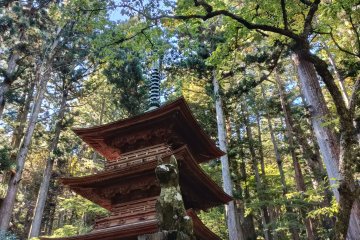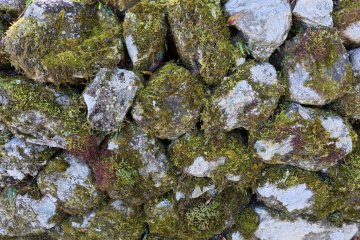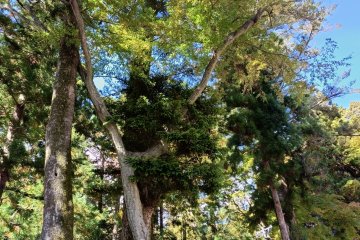Komagane City, in Nagano, part of Japan's Alps, is known for its mountain attractions, with mountains as high as 3000 meters. Mountains are also sacred, housing deities and other wondrous beings. Japanese cedar trees, in particular, gracing many mountain tops, are among the trees believed to be particularly endearing to Gods and revered as powerful sources of spirituality. In Komagane, Kozenji and Omiya Isuzu Shrines contain fine examples of these holy trees. Apart from forming majestic entrances to the shrines with their height and girth, centuries old cedar dominate the forests that shroud these shrines, heightening their aura of spirituality and mystery.
At Kozenji, a cedar lined avenue of steps leads through an impressively structured two tiered Entrance Gate, up to the Main Hall.

This Hall is all ancient and faded brown wood, but beautifully carved with dragons, serpents, and monkey like figures. The deity, Fudō Myō-ō, has the tough job of freeing the world from its miseries. He then has to be mightily powerful, and being so, needs to be hidden. There is, though, a tiny statue of the God in the back corner. More visible is the Dog Hayatoro perched outside. A magnificently carved piece of wood, gaping jaws, fangs, and all. Not quite cute and cuddly, but then he is the Protector of Fudo, and us.

On the grounds in front of the Pagoda, is another Hayatoro, a blackened stone carving, looking desolate, and who wouldn't be playing second fiddle to the handsome creature back at the Main Shrine.

The Pagoda is a grand three tiered building of plain wood, patterned like the Entrance Gate and Main Shrine, where layered beams fit into each other, strikingly embellished by the giant cedars around it. Moss colours the ground and statues with bright green, and a cordon around a nearby isolated strip declares its sanctity. Much is made of the shrine's garden with its 70 weeping cherry trees. The call of the cedar is more irresistible, themselves sunk in a variety of thick foliage. You can walk all over, take in the atmosphere, made more dramatic with ancient statues and jizo.

On the way out is a low wall of rocks haphazardly fitted onto each other. If one stoops low to look between the holes, no small acrobatic feat, and the holes light up, we're lucky. This drew a big bunch of hopefuls including me, but judging from reactions, none of us saw the light.
Kozenji, founded in 860 AD by a monk of the Tendai Sect, has been worshipped at for more than 11 centuries. It is one of the oldest temples in Nagano Prefecture.
Omiya Isuzu is visible from its thick overhanging branches practically kissing the road ahead. It is embedded within an ancient immense cedar grove, like Kozenji.

At the Main Shrine and Worship Hall, the cedars are like a wild and wonderful tangle of green. Together with the Shrine's venerated age of over 1700 years of history, they exude an air of commanding sanctity. The Shrine is beautifully plain brown wood, with intricate carvings of dragons and mythical creatures like baku, a dream devouring monster. This work of art is attributed to a carpenter in the 1900's, when the Shrine was built.

Cedars, Japan's national tree, are praised as giants holding the sky. Japan has the biggest area of cedar in the world. They, like all nature, can soothe, if not heal. Whatever, there is always a thrill keeping company with cedars and walking towards a shrine.














